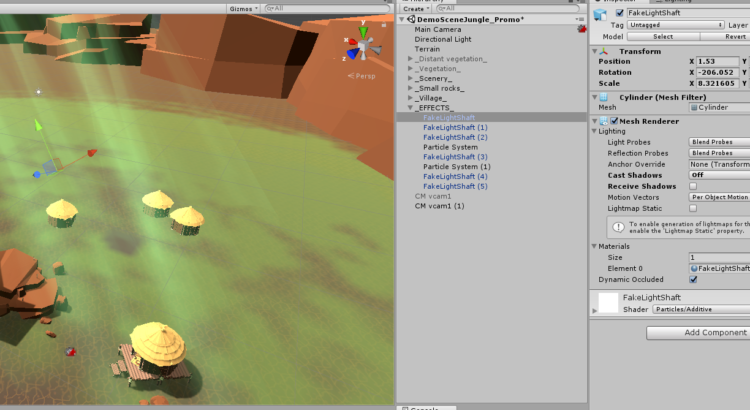Welcome back and thank you for visiting again! In the second part of this little series, I would like to tell you about POLYJungle, my first attempt in making a fully detailed polygonal environment scene and models.
Jungle environments in games were always very popular – we all have a mental image of lush, diverse green vegetation, thriving animal populations and remains of ancient civilizations or small, secluded native villages hiding in the shadows of the world’s largest trees.
Jungles are home both to natural beauty and mystery, and in video games, this makes them a perfect setting, let it be platformer-style, adventure or survival game.
Inspired by great games
Jungles are one of my favorite game settings from way early on – the first video game I ever played was Rayman by Ubisoft, released in 1995.
The story starts right in the middle of a colorful, magical rainforest, thriving with dangerous inhabitants and collectible shinies, all drawn in a very distinctive cartoon style.
Luckily, Ubisoft carried this jungle theme forward when they created more and more of Rayman’s world.

When I start to create a new environment pack, I always look first to reference and write a list about what are the key features of the scene.
In the case of the Jungle environment, I started to collect names and pictures of the most common jungle and rainforest trees, shrubs and smaller plants, as well as flowers.
I noted their size, color, and different parts (like leaves, flowers and separate branches) and decided which parts need to be separate for creating variety, and which parts should stay together in one mesh.
It was very delighting to browse beautiful orchids pictures and decide which ones should be included in the Jungle package.

Then I moved on to artificial objects. I choose tribal village with small palm huts, similar to some Amazonian dwellings. I created the hut to be medium-degree modular, which means you can have an early building stage hut, a half-built hut, and a full hut.
Of course, the future inhabitants on the jungle village will need some personal belongings, so I added a straw sleeping mat and clay jugs, as well as a few tribal masks to show their pride and individuality.


Scene building tricks
After everything was finished, I set up the Materials in Unity and built a little valley with the huts. I created this scene for showcase purposes only, so it shows its best from one angle, but with a little more work it could be expanded to be more immersive.
A little trick I made with the demoscene, is the light shafts – also known as volumetric lighting. I used a rather old-school method to achieve the light shafts and made a cone mesh, and textured it with a semi-transparent shaft texture, and set material rendering to Particles/Additive.
Of course, there are more advanced tools to create volumetric light effects, such as using a Spotlight with a light cookie (this creates the illusion of the light shining through something, like a canopy).
There are also numerous excellent volumetric effects solutions in the Asset Store, such as Aura.



I used Cinemachine virtual camera system and Unity’s built-in Post process stack to create the promo art images. With this tool, I can set up multiple virtual cameras with the same – or if needed, different – camera settings and post-process stack in different angles in the scene.
I can cycle through them and snap high-resolution images easily.
I asked Adam to write a custom Camera script for taking hi-res screenshots. With his help, I can set the desired resolution, a path to save the images, and a button (for example, “P”) to take a screenshot while in Play mode.
I hope you liked this little behind-the-scenes article and will be interested in the next article, which will feature our POLY Arctic package!

